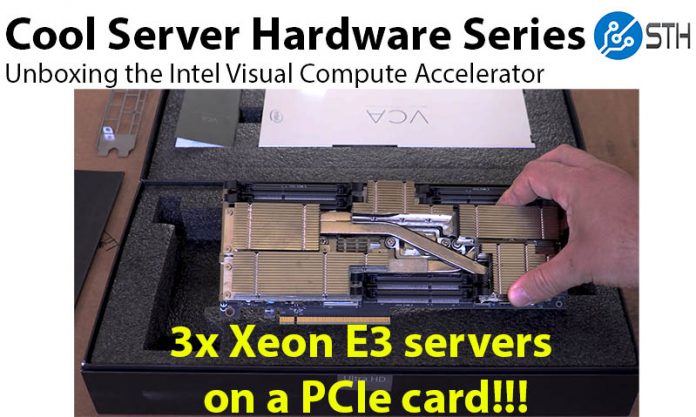As part of our Cool Server Hardware Series, we have the unboxing of the Intel Visual Compute Accelerator or VCA. The Intel VCA is insanely cool, albeit it was not the most popular card on the market. With three Intel Xeon E3-1200 V4 servers onboard the single PCIe x16 device, this is something unlike your average GPU.
Unboxing the Intel Visual Compute Accelerator
Here is our video unboxing the Intel Visual Compute Accelerator:
One can clearly see the major points here. Onboard this PCIe x16 card are three servers based on an Intel Xeon E3-1200 V4 CPU. Each node has:
- Quad-core/ eight-thread Intel Xeon E3-1200 V4 CPU
- 2.9GHz base and 3.8GHz max Turbo clocks
- GT3e Iris Pro Graphics P6300 with 128MB eDRAM
- 47W TDP
- Dual channel memory up to 2x 16GB DDR3L ECC SODIMMs
- An Intel H87 PCH chipset
This is an older VCA, and there are at least two newer versions. There is no onboard primary storage, just 16MB SPI flash. To access the network and storage, one needs to go over the PCIe bus to the host server.
One of the key use cases for the Intel VCA was as a Quick Sync video transcoding platform. Each CPU’s GT3e GPU had dedicated video transcoding engines, so organizations such as broadcasters could quickly build transcoding farms even in amazingly dense platforms.
Final Words
The goal of our Cool Server Hardware Series is to show off some of the innovation that happens in the server space to make really novel solutions. The Intel Visual Compute Accelerator is certainly one of those novel solutions.
We ran into a little snag when setting up the system. We had recycled all of our DDR3 memory, so we did not have any SODIMMs that were compatible. Once modules arrive, we plan to use this as a Kubernetes cluster on a card. One could argue that just getting a HPE ProLiant DL325 Gen10 would be less expensive, faster, easier to service, and so forth to build a virtual cluster out of, but we wanted to see if this unit still has any use to it. For us, one of the biggest points of intrigue, as we mentioned in our Looking back at Intel Xeon E3-1200 V1-V6 to the New Xeon E-2100 article, is that the Intel VCA PCIe card was one of the few places to see the Intel Xeon E-1200 V4 series. Stay tuned to STH for more on this novel platform.





And a nvidia Quadro P400 is like $85-90 , with a much more capable transcode engine. At least once you back the binary driver to allow > 2 concurrent encode sessions and be careful to manage the sessions themselves to be aware of VRAM usage.
These are single slot, no power connector needed.
1080p sources are 4-6x inputs per card. And 4k are 3-4x depending on res and number of outputs desired.
A modest ATX consumer board with 3 16x slots (likely 8x, 4x, 2x signal wise on Intel core i3) will be fine.
A workstation board with open ended slots and decent board PSU can likely support 5-7x boards.
How much are these Intel transcoders???
Sure I get they can do other stuffz but so can GPUs with CUDA.
Paul, you don’t have a great comparison. These are full servers, not just GPUs, and a single slot. Not only do they have x265 encode and decode, but they’ve got the CPUs and RAM as well. This is 3 servers in 1 slot. If you’re looking at the newer SGX card, they’ve taken this product to be 3 servers not just the transcode.
They’re also only a single x16 not multiple.
I’ve been curious about using the VCAs for a while now for non-GPU work. What is the host-board programming interface like? Does it support DMA or something similar to the Xeon Phi coprocessor model? Or is it a IP-over-PCIe solution? Or something else?
I’m really curious how they show up on the installed system. Is it plug & play? How is it handled exactly?
From what I’ve read, Intel does not sell these to the general public because they’re not “plug & play” under any reasonable/practical definition. Intel’s partners help create preconfigured systems that target specific workloads. (In particular: video transcoding.)
Well, when all you got is hammers…